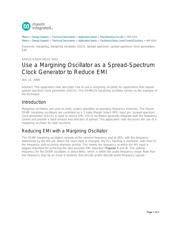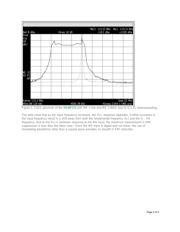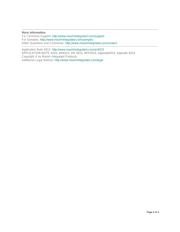herunterladen

Maxim > Design Support > Technical Documents > Application Notes > Miscellaneous Circuits > APP 4315
Maxim > Design Support > Technical Documents > Application Notes > Oscillators/Delay Lines/Timers/Counters > APP 4315
Keywords: margining, margining oscillator, SSCG, spread spectrum, spread-spectrum clock generation,
EMI
APPLICATION NOTE 4315
Use a Margining Oscillator as a Spread-Spectrum
Clock Generator to Reduce EMI
Nov 12, 2008
Abstract: This application note describes how to use a margining oscillator for applications that require
spread-spectrum clock generation (SSCG). The DS4M133 margining oscillator serves as the example of
the technique.
Introduction
Margining oscillators are used to verify system operation at operating frequency extremes. The Maxim
DS4M margining oscillators are controlled by a 3-state Margin Select (MS) input pin. Spread-spectrum
clock generation (SSCG) is used to reduce EMI. SSCG oscillators generally integrate both the frequency
control and provide a fixed amount and direction of spread. This application note discusses the use of a
margining oscillator for both functions.
Reducing EMI with a Margining Oscillator
The DS4M margining oscillators operate at the nominal frequency and at ±5%, with the frequency
determined by the MS pin. When the input state is changed, the PLL tracking is nonlinear, with most of
the frequency shift occurring relatively quickly. This makes the frequency at which the MS input is
toggled important for achieving the best possible EMI reduction (Figures 1 and 2). The optimal
frequency for the DS4M oscillators is about 8kHz, which is within the audio frequency range. Note that
this frequency may be an issue in systems that encode and/or decode audio frequency signals.¹
Page 1 of 4






